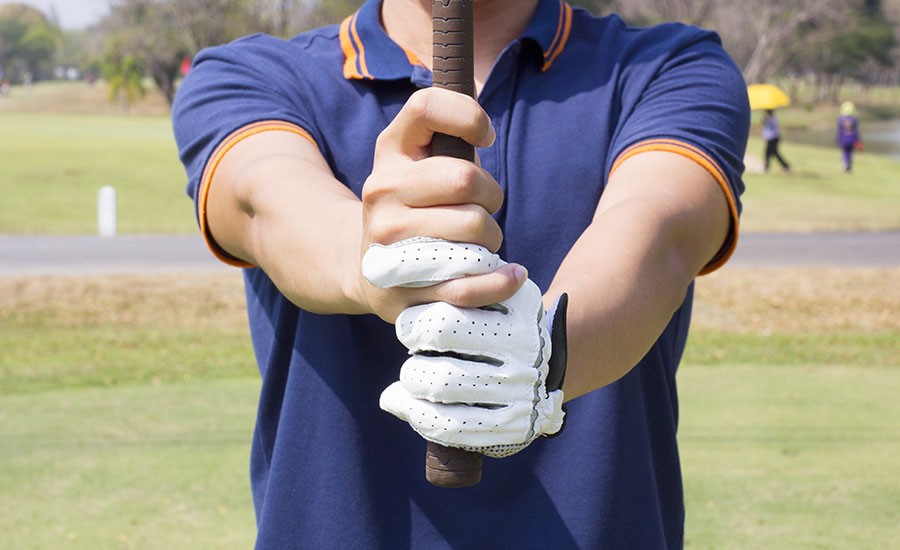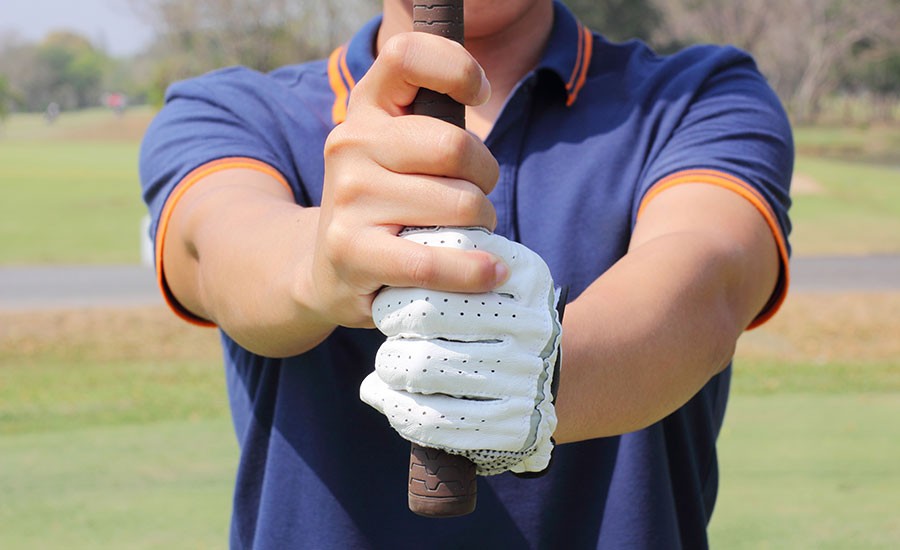Tips
Your grip is more than just a connection to your golf club—it's the foundation of your swing. A minor adjustment in how you hold your club can lead to major improvements in your game.
We’ll break down how to grip a golf club properly, guide you through different types of golf grips and list common mistakes you should avoid, to help you improve your swing and your game.
How To Grip a Golf Club Properly
Gripping a golf club correctly with the right amount of grip force can have a significant impact on the quality and accuracy of your swing.
To grip a golf club properly:
Start with your lead hand (left hand for right-handed golfers): Position the grip of the club along the base of your fingers. The grip should run diagonally from the base of your little finger to just above the pad of your index finger. This will allow the club to sit more in your fingers instead of in your palm, which is crucial for flexibility and wrist hinge during your swing.
Secure the club with your lead hand: Close your hand around the grip so that the thumb of your lead hand sits on the top of the grip, pointing down towards the club head. The thumb and index finger of your lead hand should form a 'V' shape that points towards your right shoulder.
Position your trail hand (right hand for right-handed golfers): Place the lifeline of your trailing hand (the line that curves around your thumb) over the thumb of your leading hand. The club should lie across the fingers of your trailing hand.
Secure the club with your trail hand: Close your trail hand over your lead hand, making sure your trail hand thumb is pointing down the grip, towards the clubhead. Again, the thumb and index finger of your trail hand should form a 'V' shape, which also points towards your right shoulder.
Choose your preferred grip style: Decide how to connect your hands. This could be through the interlocking, overlapping, or 10-finger grip, which we’ll cover below.
Keep in mind that your grip should be firm but relaxed. A grip that's too tight can inhibit wrist hinge and limit the fluidity of your swing.
Aim to grip the club with a pressure of 5 or 6 on a scale of 1 to 10, with 10 being the tightest.
Types of Golf Grips
There are three primary types of golf grips, each with their unique benefits. Your choice might depend on factors like hand size, comfort and your desired swing style.
The most common golf grips include:
Interlocking Golf Grip
In the interlocking grip, the index finger of the lead hand and the little finger of the trail hand interlock or hook together. This grip is common among golfers with smaller hands, as the interlocking fingers provide extra stability and security.
Many professional golfers use the interlocking grip, including the legendary Jack Nicklaus and Tiger Woods. Both have praised the interlocking grip for providing the secure connection between the hands that is critical for a cohesive and powerful golf swing.

10-Finger Golf Grip
The 10-finger grip is a type of grip where all ten fingers are in contact with the golf club. It’s relatively straightforward and intuitive to learn, making it a good starting point for beginners who are unfamiliar with more advanced golf grips. It resembles the way you might hold a baseball bat, making it more natural for those who have experience with bat-and-ball sports.
Besides beginners, this grip is also recommended for players with joint issues, or those with weaker hands and forearms, as it offers maximum grip strength.
While the 10-finger grip is less common among professional golfers compared to the interlocking grip, some pros do use it. Notable golfers who have used the 10-finger grip include the late, great Moe Norman, who was renowned for his striking accuracy and PGA Tour winner Scott Piercy.

Overlapping Grip
The overlapping grip, also known as the Vardon grip, is named after Harry Vardon — a professional golfer from New Jersey who won The Open Championship a record six times.
In this grip style, the little finger of the trail hand is placed into the gap between the index and middle finger of the lead hand. This grip can provide a great balance of control and power — especially for players with larger hands.
Many professional golfers use the overlapping grip, including notable players like Ben Hogan, Phil Mickelson and Rory McIlroy. It's the grip of choice for many pros due to its balance of security and flexibility.

The “Claw” Grip (for Putting)
The claw grip, sometimes referred to as the "saw grip," is a golf grip that is used specifically for a putter. The grip has gained popularity in recent years among professional and amateur golfers alike.
It's often used by players who are struggling with their putting, particularly when dealing with the dreaded 'yips' — a term used to describe a loss of fine motor skills in golf.
The primary benefit of the claw grip is that it helps to reduce wrist movement during the putting stroke, which can lead to greater consistency and control.
Several professional golfers such as Phil Mickelson and Sergio Garcia have adopted the claw grip — particularly later in their careers.
Common Golf Grip Mistakes To Avoid
Whether you’re a beginner or you’ve been enjoying the game of golf for quite some time, common grip mistakes can creep in and end up affecting your shot.
Here are some common grip mistakes to avoid:
Gripping too tightly: A grip that is too tight can inhibit wrist hinge, reducing the fluidity and power of your swing. Aim for a firm but relaxed grip.
Improper hand positioning: Positioning the club too much in the palm, rather than the base of the fingers, can limit the control and flexibility of your swing.
Inconsistent grip: Changing your grip between shots can lead to inconsistent swings and unpredictable shots. Once you've found a comfortable, effective grip, try to maintain it consistently.
Incorrect 'V' alignment: If the 'V's formed by the thumb and index finger of each hand aren't correctly aligned (pointing towards the right shoulder for right-handers), it can cause issues with clubface alignment, leading to less accurate shots.
How To Grip a Golf Club: FAQs
Still have questions about your grip? Find answers in some of the most frequently asked questions below.
How should a beginner grip a golf club?
For a beginner, the 10-finger (or baseball) grip is often recommended because it's relatively simple and intuitive to learn.
How do I know if my golf grip is too small?
If your grip is too small, your hands may over-rotate, which can cause the clubface to close and lead to a hook. Other signs that your grip is too small include your fingers digging into your palm when you're gripping the club or feeling like you're straining to maintain a secure hold on the club.
How do I know if my golf grip is too strong?
In golf terminology, a "strong" grip refers to turning both hands to the right (for right-handed golfers) on the club. If your grip is too strong, you may see more than two knuckles on your left hand when you address the ball. This grip can often cause the clubface to close at impact, leading to a hook.
Are thicker or thinner grips better?
The choice between thicker and thinner grips depends on personal comfort and your swing tendencies. Thicker grips can help golfers who struggle with an overactive bottom hand or those who tend to hook the ball, by limiting wrist action.
On the other hand, thinner grips can promote more wrist action, which can increase shot power and help golfers who struggle with a slice. Choosing the right thickness of your grip is as important as choosing the right golf flex shaft.
How do you grip a driver vs. an iron?
With a driver, the grip pressure should be relatively light. A tight grip can restrict the free movement of the wrists, preventing the full release of the clubhead and reducing your potential for maximum distance. When using an iron, especially for shorter approach shots, you may opt for slightly more grip pressure to provide additional control and accuracy.
Join the Links Golf Community
At Links Golf Club, we provide a contemporary approach to the conventional golf club membership, welcoming both novices and seasoned players alike.
Links Golf Club offers a chance to become part of the world's liveliest golf community. Here, you can engage with over 40,000 fellow golf enthusiasts who have a strong passion and commitment for this exquisite game.
With a membership at Links Golf Club, you get to revel in unique experiences and exclusive benefits. These include entry to elite golf courses, price reductions on golf gear and travel deals, as well as access to member-only social gatherings where you can network with other golf aficionados.
Our welcome package for new members includes:
A complimentary Limited Edition Bettinardi/Links Headcover
A $100 gift card for Five Iron Golf
Free Arccos Smart Sensors with a 45-day free trial
500 points to be redeemed for purchases in our pro shop
Joining Links Golf Club lets you unlock advantages that go beyond what a standard golf membership offers. Engage with a vibrant community, play at the most desirable golfing landscapes nationwide, and meet fellow golfers who share your love for the sport.
Membership Designed For The Modern Golfer.
Join a thriving community of like-minded golfers, experiencing the best the game has to offer, both on and off the course.
Takes less than 1 minute.

